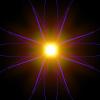 Submitted by Glow on
Submitted by Glow on

pixabay.com
How would you look for something that can be in two ‘places’ at once?
The answer, according to Oxford University research into a quantum phenomenon called superposition, seems to be to ask where it isn’t rather than where it is.
‘Superposition allows an atom to be simultaneously ‘here’ and ‘there’. Electrons behave like tiny magnets which can point both North and South at the same time,’ explains Professor Andrew Briggs of Oxford University’s Department of Materials. ‘This is a distinctive quantum effect; it is quite different from anything in our intuitive every day experience of the world.’
According to Professor Briggs you can imagine an electron as being rather like a spinning top, as it spins it generates a magnetic effect.
‘Just as a magnetic compass aligns itself with the Earth’s magnetic field, because its energy is lower when it points that way, so a single electron in a magnetic field has a different energy depending on which way its spin points,’ he says.
But in the quantum world nothing is easy: try to look directly at which way this ‘quantum compass’ is pointing and the very superposition you wanted to catch in the act – of it pointing north and south at the same time – is destroyed. Instead the superposition state will be replaced with one where the magnet is pointing either north or south at random.
To get around this problem Dr Richard George and others from Oxford worked with colleagues at TU Delft in the Netherlands to prepare a series of experiments.
The researchers used the magnetism of a single atom of nitrogen trapped in a high-purity diamond as their ‘quantum mechanical compass’.
Under laser light, the nitrogen atom fluoresced according to how it was magnetized.
Rather than asking, ‘Is the magnet pointing north or south?’ the team asked, ‘Is it pointing not east?’
The researchers studied three successive rounds of measurement on the nitrogen quantum compass, and used correlations between different rounds to prove the presence of quantum superposition in their system.
‘We had previously performed experiments in which the nuclei of our atoms had two states available to them. Now we have extended this to a superposition of three states, if you like North, South, and East,’ Professor Briggs explains.
‘The investigation involved an intermediate measurement, which was equivalent to opening one of three boxes and seeing if a ball was not in it. We showed that not only could you not tell which box had been opened; you could not even tell whether a box had been opened. This in turn, thorough some rather detailed reasoning, allowed us to prove experimentally some fundamental conjectures about the nature of reality.’
According to Professor Briggs this work is pushing the boundaries of ‘quantumness’ and developing techniques that will help to investigate whether quantum superposition applies to larger and more complex objects.
Dr George adds: ‘Our confirmation of these subtle quantum predictions is an important step on the road to transplanting quantum mechanics from a theoretical and laboratory curiosity and into the devices which we use in commerce and everyday life. Our vision is to scale up and build computers in which every ‘bit’ is replaced with a ‘quantum bit’ that uses superposition as an integral part of their operation.’
http://www.messagetoeagle.com/superposition-phenomenon-can-two-places/